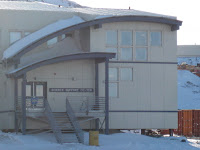The long hours of fieldwork are certainly the foundation of the United States Antarctic Program! Scientists work day and night to make the most of the short Antarctic season.
Well, there's a bit more to McMurdo. That is the part I would like to share with you. For every one scientist in McMurdo, there are 8 Support Staff. These include electricians, cooks, dish washers, recreation directors, store managers, mountaineers, carpenters, equipment operators, solid waste engineers, and so forth. These people need a liveable place to spend 5 months (since most of them make a commitment to spend that long, arriving in early October and leaving in early March.) So - here is what the non-science life in McMurdo looks like.
When people are walking down the road, everyone looks alike! And when people go to meals to a group gathering, there is a mass of red parkas! Our parkas (known as "Big Reds") are so bulky, that we always hang them outside the dining room or offices. Imagine trying to find your own parka!! Thankfully, we all have our names written prominently on the fronts.
 This photos shows one of the four Big Red bays outside the dining hall.
This photos shows one of the four Big Red bays outside the dining hall.In McMurdo, we stay in dormitories. Most of them are 2 or 3 floors tall, two per room, coed dorms, and each dorm has a lounge and a laundry room. This is what some of the dorms look like.
 They are quite comfortable, and well heated.
They are quite comfortable, and well heated. Besides dormitories, there are many different kinds of buildings. There is one main science laboratory, called the Crary Lab, built on a hillside in three levels.
 ANDRILL is one of 12 science projects currently on ice, and all of them have offices in the Crary Lab. Everywhere you go, people are busy planning for the field, or processing samples or data collected in the field. It is a very exciting place, filled with scientists from all around the world!
ANDRILL is one of 12 science projects currently on ice, and all of them have offices in the Crary Lab. Everywhere you go, people are busy planning for the field, or processing samples or data collected in the field. It is a very exciting place, filled with scientists from all around the world!
Besides the dormitories and the science lab, there are many other buildings around. Many departments in McMurdo are there to support the science efforts. Berg Field Center is where all of the field gear is kept and repaired. It's amazing to walk through and see their stash of tents and sleepingbags and ice axes and all of the other stuff you need for doing fieldwork!
The Science Support Center also supports the science efforts by holding mandatory classes to train scientists in a number of areas. My first week here, I went to "school" a lot! I went to: Sea Ice School, Survival School, and Snowmobile School - each lasting 1 - 2 days.
 People at the SSC are specially trained to teach the scientific teams, and the teachers who accompany them, these important skills.
People at the SSC are specially trained to teach the scientific teams, and the teachers who accompany them, these important skills.This is the coffee house, which is a big gathering spot in the evenings.
 I love to come here with my friends at night! The coffee house is the venue for movies on Sundays and Tuesday evenings, though I have yet to find time to take in a movie!
I love to come here with my friends at night! The coffee house is the venue for movies on Sundays and Tuesday evenings, though I have yet to find time to take in a movie!The chapel is beautifully situated on a hillside overlooking the sea ice and the ice runway. It is a non-denominational chapel, with many different types of services occurring throughout the week. As with every other space in McMurdo, the building has a multitude of other uses including yoga classes and self-help groups.

Believe it or not, there is a greenhouse in McMurdo! It is a wonderful place to go for a dose of greenery and humidity. Lettuce, cucumbers, flowers and herbs are grown in the 700 sq. ft. greenhouse.
 There are even two small hammocks to recline in to promote peaceful relaxation.
There are even two small hammocks to recline in to promote peaceful relaxation.Finally, you cannot miss the Chalet, which houses the National Science Foundation Headquarters for the U.S. Antarctic Program and the Admiral Byrd Memorial. Out front of the chalet are all the flags of the 12 Original Signatory Nations of the Antarctic Treaty - quite an impressive sign of international cooperation!



No comments:
Post a Comment